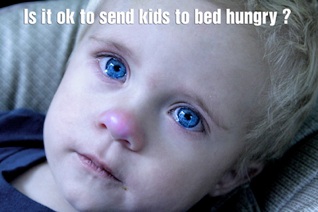Rib Count
GL Hill
Editor@TheIndependentDaily.com
Why do most Americans react to this:

But not this:

The vast majority of calls to feed the hungry depict children typically from Africa or other “under developed” or “developing” country. The truth of the matter is that there are hungry children in most every country of the world, including right here in the United States. Yet, we seem to remain more concerned with feeding other countries’ children than feeding our own; we continue to fund and feed other countries1 while allowing our government to cut funding to “Food Stamps” distributed to our own hungry children and adults through the Supplemental Nutrition Assistance Program (SNAP).
Is this charity to other countries due to the numerous reports of overweight and obese Americans? 2 The United States obesity rate is listed as 33% (South Africa’s obesity rate is 31.3%); and yet 48.8 million Americans—including 16.2 million children— live in households that lack the means to get enough nutritious food on a regular basis. This means that one out of five children in the US goes hungry.
We rant and rave about our poor education system for our children. Yet, reports indicate that hungry children regularly exhibit inability to concentrate and therefore have poor or inadequate academic performance.
The answer does not lie in making cuts to SNAP (perhaps they should have used a different acronym – because the benefits could be gone in a “SNAP” under the present House makeup). Indeed, there are many alternative routes to take in curtailing some of SNAP’s benefits to enable additional needy individuals and families to benefit from this necessary program.
One of the easiest is to further limit food products that can be purchased using SNAP benefits (current eligibility items are listed at http://www.fns.usda.gov/snap/retailers/eligible.htm). It does not take a complex study or expansion of bureaucracy to evaluate and identify “nutritional” food. It can easily be altered by adding to the ineligible group: candy, ice cream, soda, chips, pastries and cookies. All of these items, while delicious, have limited nutritional value. Second, mandatory participation in a nutrition program to educate SNAP participants in producing healthier meals on a budget would stretch their food stamp benefits (e.g., http://cookingmatters.org/what-we-do/our-program/).
Do we need to wait until American children have a higher fatality rate due to malnourishment, or, merely until we can do a visual rib count? No – the time is now for us to make certain that our children do not go hungry. In addition to NOT cutting the “Food Stamps” program, here are a few sites where you can make a difference:
http://feedingamerica.org/hunger-in-america/hunger-facts/child-hunger-facts.aspx#
http://www.fns.usda.gov/fncs-recipe-box

1 The Heritage Foundation puts the amount of US foreign food aid at more than $2 Billion per year.
2 Frequently, Obesity and Food Stamp use are cited in the same article by the popular media, such as CNN and MSN. The goal is to set that correlation firmly in your mind so that “Hungry Americans” equate to “Fat, Slovenly Americans.” It depends largely on which of the two political parties controls that particular “news” source. It’s a not-too-subtle form of Yellow Journalism practiced largely today by failing traditional news organizations and marginally-sentient writers.



